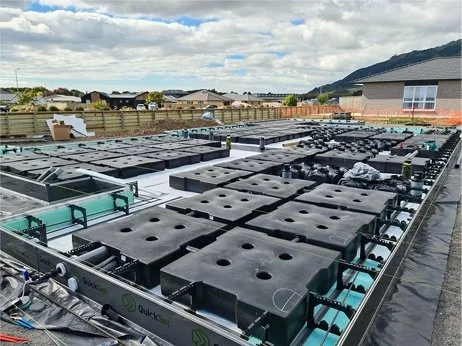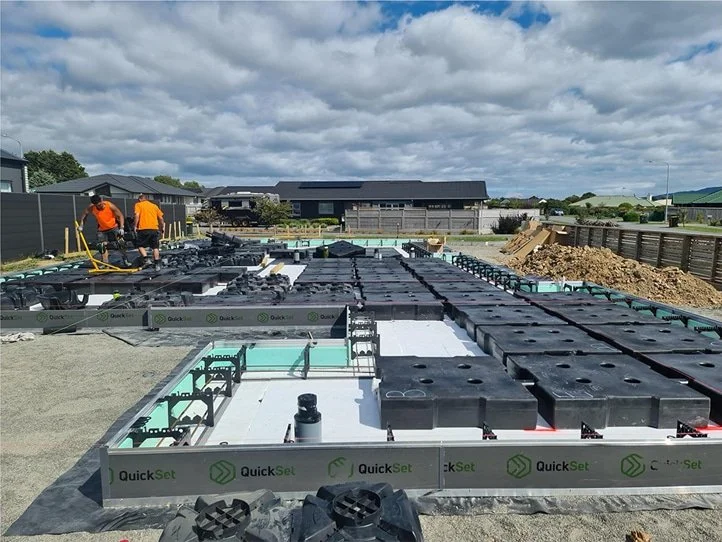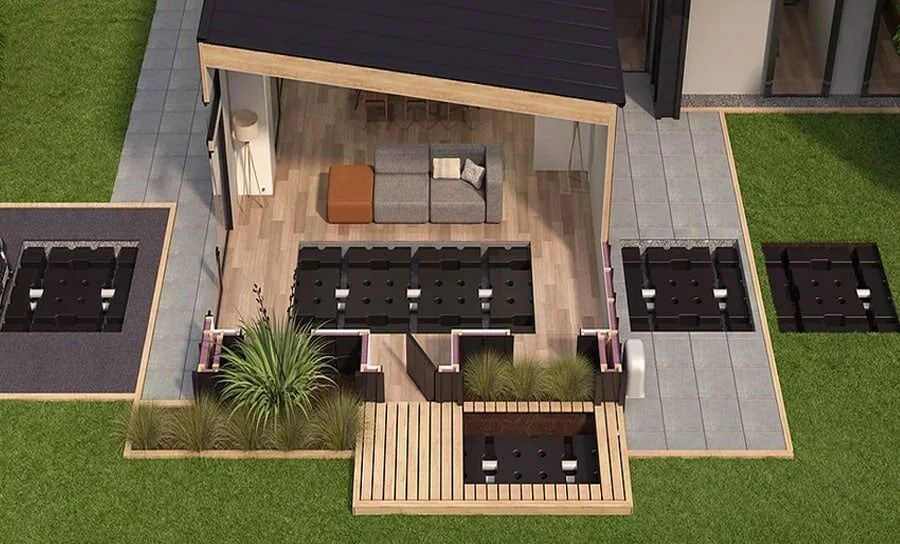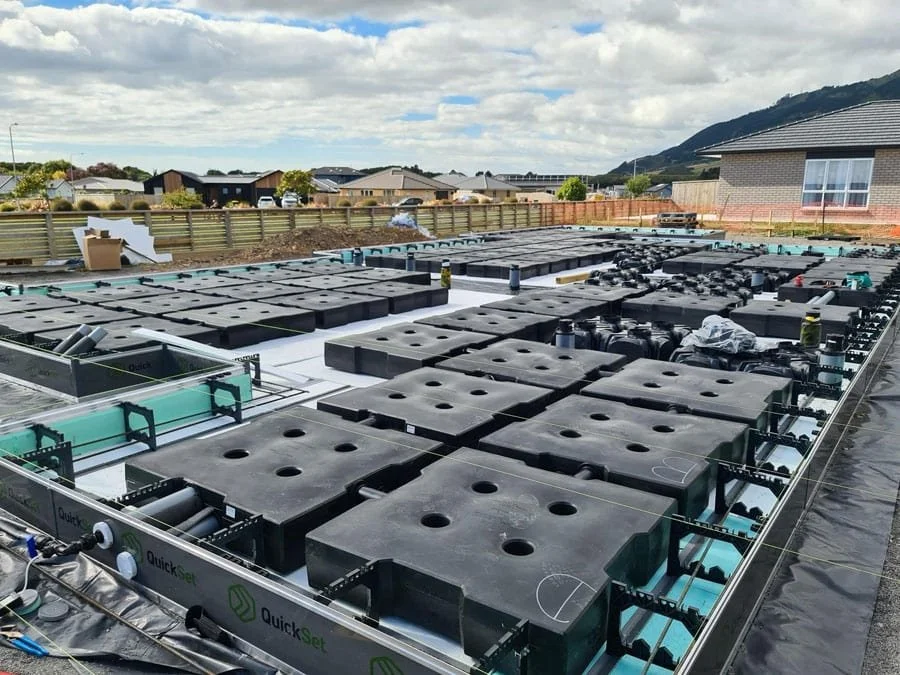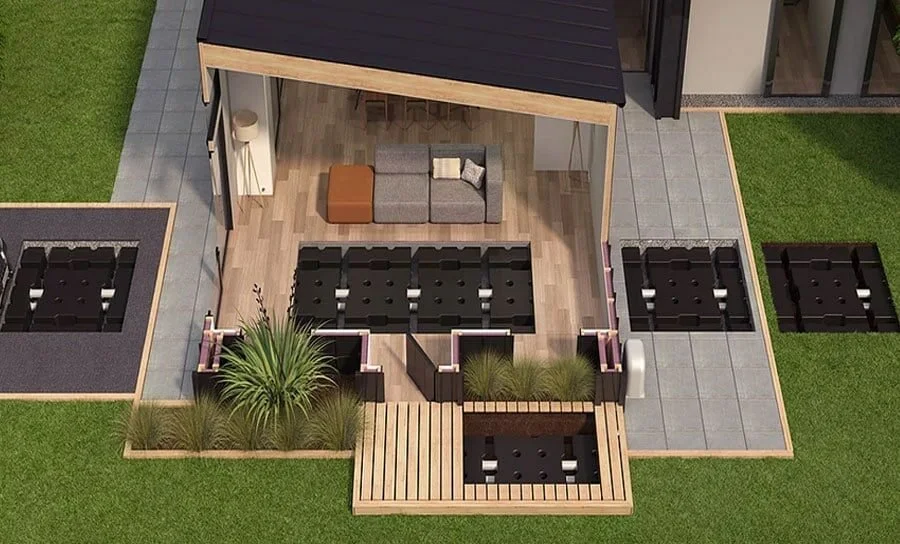
Aquacomb® On-site Detention Tank (OSD)
Stormwater Tanks & Detention Tanks NZ
→ Features
We love solving complex problems.
Lightweight
Installed in a driveway or in the slab of a house, they can still drain to a stormwater pipe with a high invert level.
Easy Install
No extra space required, use them on small and sloping sites. The solutions are endless.
Modular
Laid at grade, or in-slab means they are above council pipes but still hidden.
Surcharge Issues
Laid at grade, or in-slab, means NO issues around surcharge or space.
→ AquaPit for Aquacomb
Detention AquaPit
The Detention AquaPit is the one point of entry and exit of water to and from your Aquacomb system. All of your downpipes will be brought underground into the AquaPit. We install an outlet orifice which restricts the outflow of water down to a much lower speed, this attenuates the water, reducing peak runoff volume to the main stormwater connection. It also has an overflow for when the tanks fill up.
Re-use AquaPit
The Re-use AquaPit is the one point of entry and exit of water to and from your Aquacomb system. All of your downpipes will be brought underground into the AquaPit. We install a suction feed with a filter which the pump will pull water from to supply toilets/laundry and outdoor taps. This AquaPit also has an overflow for when the tanks are already full. Ask us how to combine detention and reuse!
Easy Maintenance
Maintenance on the AquaPit is easy, the base can be cleaned with a wet-vac to remove built-up sediment once per year.
If neither of these AquaPits suits your project, we can custom make one to suit!
Custom AquaPits: We have innovated a new custom sized AquaPit to allow the tanks to be stacked on top of each other, while still keeping the same access and cleaning ability as a single-layered system.
This AquaPit is about half the cost and twice as fast to install as traditional concrete pits of similar size.
✔ Develop Sites That Could Not Otherwise Be Developed!
Engineers have been incredibly creative with their application of Aquacomb®. They’ve been installed under stairs, against retaining walls, under grass, and even on rooftops. Aquacomb® can even be installed on sloping sites; really the only limit is your imagination!
✔ Can Be Used On Small Sites
Buried tanks cannot be installed on small sites. Aquacomb®’s solution does not require any additional land, because they are installed under existing structures.
✔ Can Be Used On Sites With High Invert Levels Or Where Discharge To Curb Is Required
Laid at grade, or in-slab means they are above council pipes but still hidden. Installed in a driveway or in the slab of a house, they can still drain to a stormwater pipe with a high invert level.
Simply swap out as many polystyrene pods as you require. They’re safer too, as no manholes are required.
See How Aquacomb Works
→ Benefits of Aquacomb®
-

Solves Difficult Sites
Handles high invert levels, surcharge issues, sloping sites, and tight spaces where traditional tanks can’t go.
-

Invisible, Space-Saving Design
Installed under driveways, in slabs, rooftops, or landscaping — no extra land or bulky above-ground tanks needed.
-

Fast, Hassle-Free Installation
Lightweight, modular units are quick to install, often in just a few hours. No excavation, cranage, or additional trades required.
-

Cost-Effective Solution
Up to 40% cheaper installed inslab than traditional underground tanks. Avoid expensive piling, excavation, and engineering fees.
-

Strong, Durable & Reliable
Designed to withstand earthquakes and heavy loads with a 2-tonne external force rating. Permanently embedded inslabe with no shifting or ‘pop-ups.’
-

Dual-Purpose & Flexible
Use for stormwater detention, water reuse, or potable storage. Customisable, modular design fits virtually any space or project.

→ Options
Aquacomb® isn’t just an underground water tank. It is a clever way to capture, reuse and detain water while preventing the loss of valuable space around your development. Being modular, the overall capacity of an average system can vary anywhere from 3,000 to 30,000 litres.
Depending on if you have a larger detention requirement or large reuse need, you can customise how many Aquacomb® pods you allocate for each purpose
250L Pods
1100mm long
1100mm wide
225mm high
250L Storage Capacity
350L Pods
1100mm long
1100mm wide
300mm high
350L Storage Capacity
→ Installation
How Aquacomb® Is Installed
Aquacomb® systems are designed to fit into any type of slab construction and are especially suitable for waffle pod slab construction for housing.
To ensure compliance with the council’s stormwater regulations, Aquacomb® pods are installed by a plumber or drain layer who is approved by Aquacomb®.
100% Recyclable.
New Zealand's Only Whole-System Water Experts: Stormwater Management & Water Sustainability
Case studies are a great way to understand how our products are being used in the real world. They provide a glimpse into the success stories of our customers, and show us how our products have helped them achieve their goals.
Explore In-Depth Case Studies
→ Download Resources
Technical Pack
This pack contains
- Technical Manual
- Specifiers Information
- Architect & Engineers Brochure
- Wellington Water Approved Solutions
- H1 Ammendment Opinion
Compliance Pack
This pack contains
- PS1
- BRANZ Appraisal
- Building Performance Information Form
Installation Pack
This pack contains
- Site Prep Examples
- Project Manager’s Install Guide
Homeowners Pack
This pack contains
- Aquacomb Brochure
- Owner’s Manual
- Aquacomb Warranty
Aquacomb® FAQ's
-
Encased in concrete: In a slab foundation, under a driveway or carpark. The pods can be stacked up to three high under decks or under houses on piles, or under your garden/lawn. The only limitation is your imagination!
-
Aquacomb® can be only be installed by the highly skilled team at Watersmart (or any Aquacomb Approved Installer) this is part of our strict quality control process.
-
Short answer – They won’t! In over 15,000 installs over 15 years in Australia and New Zealand there has not been a single leak, so we are very confident that if the system is installed by our team there will be no problems.
-
Each Aquacomb® is 1100mm x 1100mm and either 225mm (250L) or 300mm (350L) deep. When joined with connecting pipework we allow 1.44m2 for each Aquacomb® pod.
-
We divert all (or majority) of downpipes from the roof to a centralised location at the AquaPit, which acts as a gateway in and out of the Aquacomb® system.
-
Our overflow prevention system is extremely simple but effective. If the system ever fills up past 100% the water will simply be diverted to the council stormwater connection through an overflow pipe in the AquaPit.
-
The key to a long-lasting system is debris and sediment prevention. From the start every downpipe feeding water into the system should have a leaf diverter to divert leaves away from the tank, and our specially designed AquaPit stops sediment entering the system.
That being said, annually we recommend you inspect gutters, leaf diverters and AquaPit for any debris.
To learn more about maintenance, view our Homeowners Manual.
-
Independent testing by Design Navigator (the online tool used by architects to model thermal performance of buildings for Building Consent) determined that the effects on insulation properties was less than the margin of error in the calculator, therefore deemed to be the same as polystyrene void formers in a slab.
Even so if using in-slab heating systems we do tend to stay away from living areas when designing systems, opting for areas such as garage floors.
-
Since we manufacture our own tanks, we remain in complete control of the process. Pods are rotomolded, so there are no seams, joints, or glues required. Each pod is formed as a whole. In our factory, we pressure test each pod to 20 kPa and try to make them ‘pop’; at a far greater rate than there is likely to be any air in the product.
Then we measure each to make sure the thickness is at least 5mm. Each pod has its own serial number, which can be tracked throughout the entire manufacturing process. On installation, pods are pressure tested again once they reach site. When steel is attached to the pods, they are pressure tested again, and then again once concrete is poured (only in Auckland). Afterwards, the installer will issue a PS3.
Multiple tests are carried out during production and installation to ensure that the product is fit for its intended purpose. All pressure tests are recorded. You don’t have to worry about slow leaks, because you will hear them! The sound is so loud it’s been likened to a freight train.
-
Watersmart engaged Digital Navigators to conduct a thermal modelling report. Details of the full report can be obtained from the Aquacomb® thermal modelling report. Please get in touch to request a copy of this report.
-
The system we use is part of an engineered solution, which is incorporated into an engineer’s floor slab. Chesters Consultants has worked with us to create a series of recommended specifications for the use of Aquacomb® in slabs, drives, and paths. Aquacomb® can withstand a 15 degree flex, and is integrated within the concrete slab.
-
As soon as the system is encased in concrete, it becomes part of the slab. It can withstand a 15 degree flex without compromise. Geotech reports that highlight problems with the soil will be incorporated into the whole slab design. Because the pods form part of the slab, the engineering is designed to account for where that slab is going.
-
Some people initially think that concrete, being strong and tough, would be the best material to use for water storage. However concrete has many disadvantages over a plastic-like PE.
Concrete is porous and will lose water over time. Polyethylene plastic is not porous so water will never escape through the tank walls.
PE plastic is much lighter than concrete in any application, meaning a plastic tank is much easier and much cheaper to install than a concrete tank.
Polyethylene is extremely inert (non-reactive) so it will never rust or corrode and it can never rot or degrade in place. This also means it is safe for drinking water as the plastic can never flake off or dissolve into the water.
PE plastic is 100% recyclable so if it is ever taken out in the future it can be reused or recycled, while a concrete tank would just be smashed and sent to hard fill.







